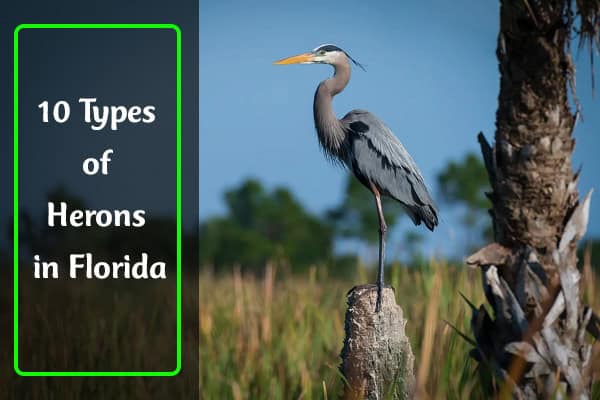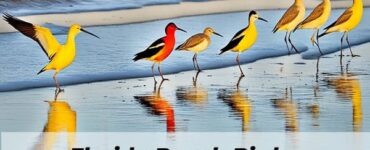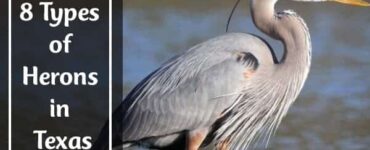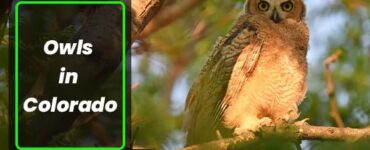Herons in Florida: Florida is a place with lots of different animals, and one cool bird you can find there is the heron. Also, These birds are really pretty and can be seen in many places like lakes, rivers, and even near the ocean. They have long legs, pointy beaks, and feathers that look different from one heron to another.
What makes herons special is how they can stand super still, like a statue, for a long time. This helps them catch fish or frogs for food without being noticed. They’re important because they keep the number of these creatures just right.
In this article, we’re going to learn about the kinds of herons living in Florida, what they do every day, what they eat, and how people are helping to make sure herons stay safe and healthy.
Here we’ll learn about 10 types of Herons in Florida
1. Green Heron
- Scientific name: Butorides virescens
- Life span: 7 years
- Size: 38-50 cm
- Weight: 0.1-0.2 kg
- Wingspan: 58-66 cm
- Status: Least Concern
The Green Heron is a small bird that lives in North America, especially in Florida’s wetlands. They’re not big, but they’re really pretty with greenish-black feathers, a brown neck, and bright yellow legs.

Interestingly, these herons are super smart—they use tools to catch fish, which is something not many birds can do. They drop things like twigs or bugs on the water to trick fish into coming closer.
Also, these clever birds build their nests out of sticks and leaves in trees close to water. They usually have 3 to 5 eggs, and both mom and dad heron take turns keeping the eggs warm for about a month.
When the baby herons hatch, they don’t have any feathers and can’t do much, but they grow quickly. Their parents feed them until they’re ready to fly on their own, which takes about four weeks.
Even though Green Herons are doing okay right now, it’s important to take care of the places where they live. Wetlands are their homes, and if we don’t protect these areas, the herons could be in trouble. So, people are working to keep these habitats safe for the herons and other wildlife.
2. Great Blue Heron
- Scientific name: Ardea herodias
- Life span: 15 years
- Size: 91-137 cm
- Weight: 2-3.6 kg
- Wingspan: 167-201 cm
- Status: Least Concern
In Florida, you can spot the Great Blue Heron, a big bird with cool blue-grey feathers and a black stripe over its eye. They love to wade in shallow waters, looking all graceful.

These birds are pretty special. They stick with one partner and keep coming back to the same spot to build their nests every year. They make these big nests out of sticks in trees near water when it gets cold, and the male shows off to find a female.
The female lays about 2 to 6 eggs, and both parents take turns keeping them warm. After a month, little herons hatch, and in two months, they’re ready to fly off.
Great Blue Herons eat a lot of fish, but they also munch on bugs, frogs, and even small animals. They’re really good at catching their food with their long beaks.
People in Florida are working hard to keep these birds safe by protecting the places where they live and making sure buildings don’t harm their homes. Because of this, the herons are doing pretty well and aren’t in danger of disappearing.
3. American Bittern
- Scientific name: Botaurus lentiginosus
- Life span: 6 years
- Size: 58-81 cm
- Weight: 0.4-1 kg
- Wingspan: 91-104 cm
- Status: Least Concern
The American Bittern is a cool bird that lives in wetlands all over North America, including Florida. They’re hard to see because their brown stripes help them hide in the grass.

When they feel scared, they do something amazing—they stretch their necks and look up, blending in just like a stick! Plus, they make a loud “gulp” sound that can be heard far away, especially when the boys are trying to impress the girls or keep others away from their space.
Even though not many people know about them, these birds are super important for keeping wetlands healthy.
In Florida, American Bitterns build their nests on the ground, hidden in tall grass. Springtime is when they start looking for a mate, and the boys make fancy moves to get noticed.
The mom lays 3 to 5 eggs, and both parents help keep them warm. After about a month, baby birds hatch, and in six weeks, they’re flying!
These bitterns eat fish, frogs, snakes, and bugs. They’re great at hunting because they can stay hidden and surprise their food.
Sadly, their homes in Florida are disappearing, but now people are trying to save the wetlands where they live. Luckily, these birds aren’t in danger of going extinct right now.
4. Great Egret
- Scientific name: Ardea alba
- Life span: 15 years
- Size: 81-101 cm
- Weight: 0.7-1.4 kg
- Wingspan: 140-170 cm
- Status: Least Concern
The Great Egrets in Florida is a big, white bird that lives in Florida. It’s got a huge wingspan—up to five feet—and it stands out because it’s all white with a yellow beak.

A long time ago, people really liked the feathers of these birds for clothes and hats, which almost made them disappear. But, thanks to people taking care of them, there are lots of these birds now.
These egrets build their nests in trees near water and lay 3-4 eggs. Both the mom and dad egret take care of the eggs, and when the babies hatch, they look like little balls of fluff. The parents feed them until they’re ready to fly in about six weeks.
Great Egrets are good at catching fish, frogs, and even small animals. They wait in the water and then grab their food with a quick move.
Sadly, they were almost gone because of their feathers, but now they’re safe, and we don’t have to worry about them disappearing.
5. Yellow-crowned Night-Heron
- Scientific name: Nyctanassa violacea
- Life span: 23 years
- Size: 58-66 cm
- Weight: 0.5-1 kg
- Wingspan: 91-112 cm
- Status: Least Concern
In places like Florida and other parts of the Americas, there’s a bird called the Yellow-Crowned Night Heron. It’s mostly grey with a cool black and white stripe on its head and a yellow spot. What’s neat is that they use tools like sticks to catch their food, which is pretty smart for a bird!

These herons in Florida build their nests up high in trees near water. Mom and Dad both help keep the eggs warm and feed the baby birds. They even wait to start sitting on the eggs so that the babies hatch when there’s lots of food around.
They mostly eat fish, but they also like to snack on things like crayfish, crabs, and shrimp. They’re good at hunting, especially at night or when it’s getting dark because they can see well.
Sometimes, they even take eggs from other birds’ nests!
In Florida, these herons are doing okay, but their homes are in danger because of things people do, like building too much or making the water dirty. So, there are special plans to help keep their homes safe. Even though they’re not in big trouble everywhere, in Florida, they need some extra help.
6. Cattle Egret
- Scientific name: Bubulcus ibis
- Life span: 9 years
- Size: 46-56 cm
- Weight: 0.2-0.5 kg
- Wingspan: 88-96 cm
- Status: Least Concern
Cattle Egrets are neat birds you can find in Florida. They’re white with a yellow-orange beak and hang out in fields with animals like cows and horses.

They got their name because they started following cows around in the 1930s, eating bugs that the cows stirred up.
These friendly birds make their homes in trees or bushes, using sticks to build nests. They lay 3-5 eggs, and both mom and dad egret take care of them for about three weeks.
When the baby egrets hatch, they’re all fluffy and white. Their parents feed them until they can fly, which takes about four weeks.
Cattle Egrets eat lots of different things, like insects, mice, and frogs. They’re known for sitting on cows, which is why some people call them “cowbirds.” They like to stick together in big groups and need farms to live and find food.
7. Black-Crowned Night-Heron
- Scientific name: Nycticorax nycticorax
- Life span: 20 years
- Size: 61-69 cm
- Weight: 0.6-1.2 kg
- Wingspan: 91-122 cm
- Status: Least Concern
The Black-Crowned Night-Heron is a bird that’s all over the world, except for the super cold Antarctica. They’re easy to spot with a black hat and back, grey wings, and red eyes that really stand out. They have a cool beak that’s great for catching all sorts of snacks like fish and bugs.

In Florida, these birds are like ninjas. They wait super still by the water and then—bam!—they grab a fish or frog. They’re night owls, making their homes in trees near water and hanging out with other herons.
When it’s time for babies, the male heron dances to impress the female. Then, they take turns sitting on 3-5 eggs for a month. The baby herons are fluffy and cute, and they learn to fly in about six weeks.
But these birds need our help. Their homes are disappearing, and a long time ago, people hunted them for their pretty feathers. Now, we’re trying to keep their homes safe so they can stick around for a long time.
8. Snowy Egret
- Scientific name: Egretta thula
- Life span: 17 years
- Size: 56-66 cm
- Weight: 0.3-0.6 kg
- Wingspan: 86-102 cm
- Status: Least Concern
The Snowy Egret is a pretty bird you can find in wet places like marshes and along the coast in North and South America. It’s easy to see because it has bright white feathers, black legs, and yellow feet.

A long time ago, people really wanted the Egret’s feathers for clothes, which almost made them disappear by the end of the 1800s. But people worked hard to protect them, and now there are lots of Snowy Egrets living happily in their natural homes.
These birds build their nests out of sticks in trees near water. Also, They like to live in groups, often with other kinds of birds that like water. They lay 2 to 5 eggs, and both mom and dad Egret take turns keeping the eggs warm for about three weeks.
When the baby Egrets hatch, they’re covered in fluffy feathers and get food from their parents. After six weeks, they’re ready to fly on their own.
The Snowy Egret is great at catching food like fish, bugs, and little water animals. It moves quietly and then quickly grabs its food with its beak. It even has a special trick where it shakes its feet in the water to scare the food into moving so it can catch it.
In Florida, these Egrets were once super popular for their feathers, which were even more valuable than gold in making fancy clothes. But now, they’re safe and can be seen showing off their beautiful feathers in the wild.
9. Least Bittern
- Scientific name: Ixobrychus exilis
- Life span: 6 years
- Size: 28-36 cm
- Weight: 0.1-0.2 kg
- Wingspan: 41-51 cm
- Status: Least Concern
The Least Bittern Herons in Florida is a small bird that’s part of the heron family. You can spot them in places with lots of water, like marshes, all over North America. They have a cool pattern of brown, black, and white on their feathers.

Even though they’re tiny, they have big feet that help them walk on plants that float on water. They make a unique sound that goes like “coo-coo-coo” or sounds like they’re laughing.
They’re pretty shy, so you might not see them easily. But if you’re patient, you can find them near the water’s edge, poking around with their long bills to catch something to eat.
In Florida, these birds are super sneaky about where they build their nests, so it’s tough to find them. They use sticks and stuff to make a strong nest in thick plants near the water.
They lay 3 to 6 eggs, and both the mom and dad bird keep the eggs warm for about three weeks. The baby birds are all fluffy when they hatch, and their parents feed them until they’re ready to fly in about five weeks.
The Least Bittern is a great hunter in Florida. They eat lots of different things like fish, frogs, bugs, and even small animals. If there’s not much food, they’ll eat plants instead. They’re good at using their sharp beaks to catch their food.
Check Our Previous Articles:
10. Tricolored Heron
- Scientific name: Egretta tricolor
- Life span: 7 years
- Size: 58-76 cm
- Weight: 0.2-0.4 kg
- Wingspan: 91-97 cm
- Status: Least Concern
The Tricolored Heron is a stunning bird that lives in the Americas and the Caribbean. Its body is a beautiful blue-grey color, and it has maroon and white feathers on its neck and chest that make it stand out.

When it hunts, the Tricolored Heron does something cool: it uses its wings to make a little roof over its head. This helps it see its food better. You can often find this heron in wetlands near the coast, where its striking looks and special way of hunting make it a popular bird to watch.
In the southern parts of the United States, including Florida, these birds build their nests in trees or bushes near other wading birds. They’re social nesters!
When it’s time to find a partner, the Tricolored Herons in Florida show off by snapping its bill and stretching its neck. Once they’re a couple, the female lays 2 to 6 eggs. Both parents take turns keeping the eggs warm for about three weeks. When the chicks hatch, they’re covered in soft feathers and get food from their parents until they’re ready to fly at around six weeks old.
Frequently Asked Questions
Q1. What type of herons live in Florida?
Various heron species inhabit Florida, including the Great Blue Heron, the Tricolored Heron, and the Little Blue Heron.
Q2. What do herons eat in Florida?
Herons in Florida primarily feed on fish, but they also consume amphibians, reptiles, insects, and occasionally small mammals and birds.
Q3. Are egrets in Florida?
Yes, several egret species are found in Florida, such as the Great Egret, the Snowy Egret, and the Cattle Egret.
Q4. What kind of cranes are in Florida?
The Sandhill Crane is the most common crane species in Florida, often seen in wetland habitats and grassy plains.





Add comment